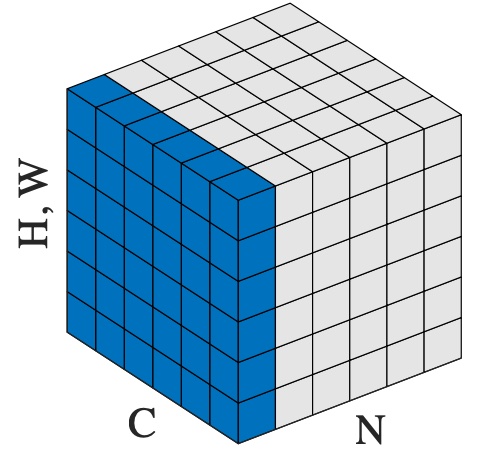LayerNorm¶
- class torch.nn.LayerNorm(normalized_shape, eps=1e-05, elementwise_affine=True, bias=True, device=None, dtype=None)[source]¶
Applies Layer Normalization over a mini-batch of inputs.
This layer implements the operation as described in the paper Layer Normalization
The mean and standard-deviation are calculated over the last D dimensions, where D is the dimension of
normalized_shape. For example, ifnormalized_shapeis(3, 5)(a 2-dimensional shape), the mean and standard-deviation are computed over the last 2 dimensions of the input (i.e.input.mean((-2, -1))). and are learnable affine transform parameters ofnormalized_shapeifelementwise_affineisTrue. The standard-deviation is calculated via the biased estimator, equivalent to torch.var(input, unbiased=False).Note
Unlike Batch Normalization and Instance Normalization, which applies scalar scale and bias for each entire channel/plane with the
affineoption, Layer Normalization applies per-element scale and bias withelementwise_affine.This layer uses statistics computed from input data in both training and evaluation modes.
- Parameters
normalized_shape (int or list or torch.Size) –
input shape from an expected input of size
If a single integer is used, it is treated as a singleton list, and this module will normalize over the last dimension which is expected to be of that specific size.
eps (float) – a value added to the denominator for numerical stability. Default: 1e-5
elementwise_affine (bool) – a boolean value that when set to
True, this module has learnable per-element affine parameters initialized to ones (for weights) and zeros (for biases). Default:True.bias (bool) – If set to
False, the layer will not learn an additive bias (only relevant ifelementwise_affineisTrue). Default:True.
- Variables
weight – the learnable weights of the module of shape when
elementwise_affineis set toTrue. The values are initialized to 1.bias – the learnable bias of the module of shape when
elementwise_affineis set toTrue. The values are initialized to 0.
- Shape:
Input:
Output: (same shape as input)
Examples:
>>> # NLP Example >>> batch, sentence_length, embedding_dim = 20, 5, 10 >>> embedding = torch.randn(batch, sentence_length, embedding_dim) >>> layer_norm = nn.LayerNorm(embedding_dim) >>> # Activate module >>> layer_norm(embedding) >>> >>> # Image Example >>> N, C, H, W = 20, 5, 10, 10 >>> input = torch.randn(N, C, H, W) >>> # Normalize over the last three dimensions (i.e. the channel and spatial dimensions) >>> # as shown in the image below >>> layer_norm = nn.LayerNorm([C, H, W]) >>> output = layer_norm(input)

